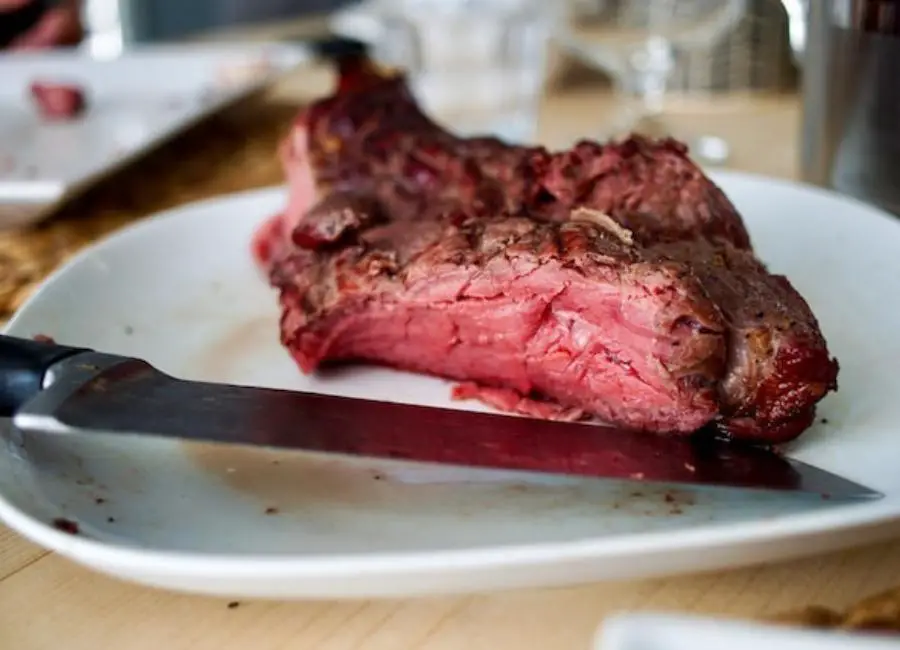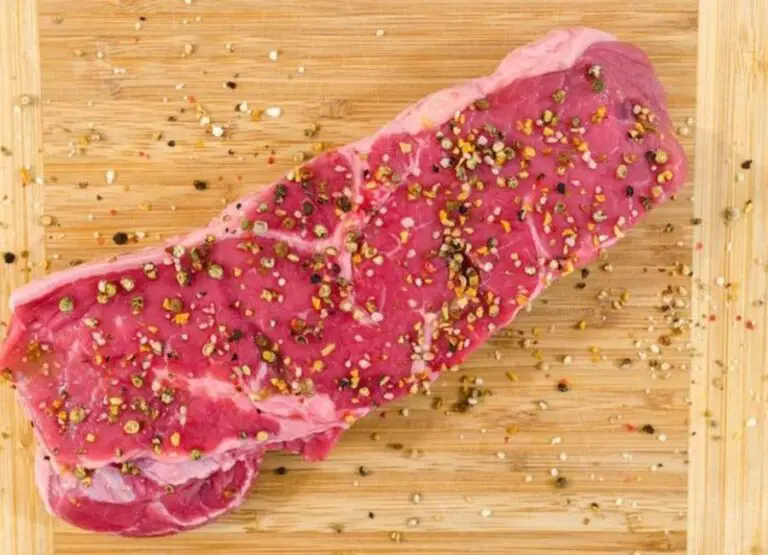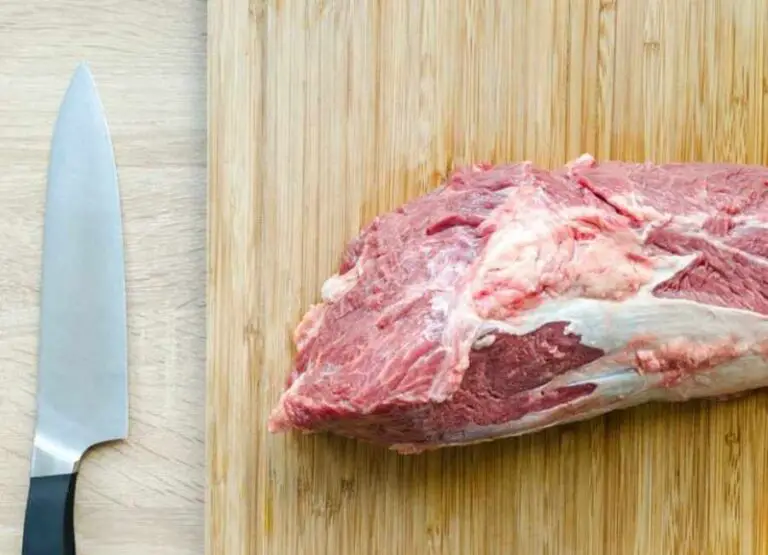Is Lean Red Meat Bad For You [Answered]
Lean red meat is a staple in many diets, but it has also been the subject of much debate in the health world.
With conflicting information and opinions on the topic, it can be hard to know what to believe.
Is it really bad for you? Is it something you should cut out of your diet altogether?
In this post, we’ll explore the facts and myths surrounding lean red meat, and give you the information you need to make an informed decision about whether or not it belongs on your plate.
Understanding Lean Red Meat
Lean red meat refers to cuts of meat that have lower fat content compared to other types of red meat. It primarily includes cuts like sirloin, tenderloin, and top round, which contain less marbling and visible fat. Lean red meat is a rich source of high-quality protein, essential vitamins, and minerals.
Is Lean Red Meat Bad For You
No, lean red meat is not necessarily bad for you. In fact, it can be a good source of important nutrients like iron, zinc, and vitamin B12. However, it is important to eat red meat in moderation and choose lean cuts to reduce the intake of saturated fat.
The World Health Organization recommends limiting the consumption of red meat to less than 500 grams per week for optimal health outcomes.
Nutritional Content of Lean Red Meat
Lean red meat is a good source of several important nutrients, including protein, iron, zinc, and vitamin B12. According to Healthline, 4 ounces (113 grams) of 80% lean ground beef contains roughly:
- Protein: 18.9 grams
- Fat: 13.6 grams
- Calories: 215
- Iron: 2.7 milligrams
- Zinc: 4.3 milligrams
- Vitamin B12: 1.5 micrograms
Meanwhile, a 3-ounce (85-gram) serving of 97% lean ground beef contains approximately:
- Protein: 22 grams
- Fat: 3.0 grams
- Calories: 137
- Iron: 2.5 milligrams
- Zinc: 3.9 milligrams
- Vitamin B12: 2.1 micrograms
Lean meats, including lean red meat, can be a healthy addition to a balanced diet. However, it is important to consume red meat in moderation and to choose lean cuts to avoid consuming excess unhealthy fats.
Potential Health Benefits of Lean Red Meat
Lean red meat can provide numerous potential health benefits. These include:
A. Source of high-quality protein
Lean red meat is an excellent source of high-quality protein, which is essential for building and repairing muscles, as well as maintaining the overall health of your body. One of the benefits of protein is that it helps you feel full, which can assist with weight management and reduce overeating.
B. Essential nutrients for overall health
Lean red meat is also rich in several essential nutrients, including iron, zinc, and B vitamins (such as vitamin B12), which are important for maintaining good health. These nutrients play a vital role in supporting various bodily functions, including the immune system, nervous system, and metabolism.
C. Iron absorption and prevention of anemia
Iron is an essential mineral that is found in red meat. It is crucial for maintaining healthy blood oxygen levels and preventing anemia. Consuming lean red meat can assist in the absorption of iron and support the prevention of iron deficiency anemia, which is a condition caused by a lack of sufficient iron in the body.
D. Role in muscle building and maintenance
Lean red meat is a rich source of protein, which is essential for muscle building and maintenance. This is because protein provides the building blocks (amino acids) necessary for muscle growth and repair. Eating lean red meat post-exercise helps to promote muscle recovery and growth.
E. Provide Omega-3 Fatty Acids
While red meat is not typically considered a source of Omega-3 fatty acids, some research suggests that grass-fed beef may contain higher levels of these healthy fats. Omega-3 fatty acids have been linked to numerous health benefits, including reducing inflammation and improving heart health.
Potential Risks of Consuming Lean Red Meat
Lean red meat is a rich source of many essential vitamins and minerals, including iron, zinc, and vitamin B12. However, excessive consumption of lean red meat may also come with certain potential risks.
A. Saturated fat and cholesterol content
Saturated fat and dietary cholesterol are two major components of lean red meat. High intake of saturated fat has been associated with elevated levels of low-density lipoprotein (LDL) cholesterol, which is a well-established risk factor for heart disease. In addition, red meat is often cooked at high temperatures, which can result in the formation of harmful compounds that may increase the risk of cancer.
B. Association with cardiovascular diseases
Several studies have suggested that high consumption of red meat, particularly processed red meat, is associated with an increased risk of cardiovascular diseases (CVDs), such as heart disease and stroke. This risk may be partly due to the high levels of saturated fat and cholesterol found in red meat.
C. Possible link to certain cancers
Increased consumption of red meat, especially processed meat, has been linked to an increased risk of certain types of cancer, such as colorectal cancer. The exact mechanisms by which red meat consumption may contribute to cancer development are still under investigation, but it is thought that some of the harmful compounds formed during high-temperature cooking may be involved.
D. Impact on gut health and microbiome
The impact of red meat consumption on gut health and the gut microbiome is an area of active research. Some studies have suggested that high consumption of red meat may be associated with an altered gut microbiome, which may have negative implications for overall health.
It has been hypothesized that this effect may be due to the high levels of heme iron and other components found in red meat that can influence gut bacteria. However, more research is needed to fully understand the impact of red meat consumption on gut health and the microbiome.
It is important to note that lean red meat, when consumed in moderation and as part of a balanced diet, can be a healthy and nutritious food. However, excessive consumption may come with certain potential risks, and it is recommended to consume it in moderation.
Balancing Lean Red Meat in a Healthy Diet
Incorporating lean red meat into a balanced eating plan involves considering portion sizes and overall dietary patterns.
Here are some tips for including lean red meat responsibly:
- Portion Control: Opt for recommended serving sizes of lean red meat, which is typically around 3-4 ounces. Pair it with generous servings of vegetables, whole grains, and other nutrient-dense foods.
- Variety: Diversify your protein sources by including lean poultry, fish, legumes, and plant-based proteins in your diet. This helps ensure a well-rounded nutrient intake.
- Cooking Methods: Choose healthier cooking methods like grilling, baking, or broiling rather than frying. This reduces the overall fat content of the meal.
- Organic and Grass-Fed Options: When possible, choose organic or grass-fed lean red meat, which may have higher levels of beneficial nutrients such as omega-3 fatty acids.
Tips for Preparing and Cooking Lean Red Meat
- Choose the right cut: Select lean cuts of meat, such as top sirloin, round steak, or flank steak.
- Trim the fat: Remove any visible fat before cooking to further reduce the fat content and prevent flare-ups on the grill.
- Marinate the meat: Use a marinade to tenderize and add flavor to the meat.
- Season with herbs and spices: Use herbs and spices to add flavor without adding extra salt or fat.
- Use healthy cooking methods: Opt for healthy cooking methods, such as grilling, broiling, roasting, or baking, rather than frying.
- Cook to the right temperature: Use a meat thermometer to ensure the meat is cooked to the correct temperature to kill harmful bacteria and ensure food safety.
- Let the meat rest: Let the meat rest for a few minutes after cooking to allow the juices to redistribute and the meat to become more tender.
- Slice against the grain: Slice the meat against the grain to make it more tender to eat.
- Be mindful of portion sizes: Limit portion sizes to 3-4 ounces per serving to keep calories and fat in check.
Alternatives to Lean Red Meat
When it comes to replacing red meat in your diet, there are several options to choose from.
Below are some alternatives to red meat based on different protein sources:
A. Plant-based protein sources
Plant-based protein sources include legumes, nuts, seeds, soy products, and grains. These are great alternatives to red meat because they are typically low in saturated fat and high in fiber. Legumes like lentils, chickpeas, and kidney beans are excellent sources of protein and can be used in a variety of dishes, such as stews, salads, or veggie burgers.
Nuts and seeds, such as almonds, chia seeds, and quinoa, are also high in protein and can be incorporated into meals in different forms. Soy products like tofu and tempeh are also great alternatives to red meat, as they have a similar texture and can be used in a variety of dishes. Grains like quinoa and farro are also high in protein and can be used as a base for salads or as a side dish.
B. Poultry and fish options
If you still want to consume animal-based protein, there are several options other than red meat. Poultry, such as chicken and turkey, are leaner options and can be used in a variety of dishes, such as stir-fries, salads, and soups. Fish, such as salmon, tuna, and mackerel, are also great sources of protein and are rich in heart-healthy omega-3 fatty acids. These can be grilled, baked, or added to salads or pasta dishes.
C. Other lean animal proteins
If you prefer other animal-based proteins, there are still several options that are leaner than red meat. This includes pork tenderloin, lean cuts of beef like sirloin and flank steak, and low-fat dairy products like milk, yogurt, and cheese. These can be used in a variety of dishes, such as sandwiches, wraps, and salads.
Learn more about how much red meat is safe.
FAQs
Is lean red meat bad for your health?
There is no definitive answer to this question as it depends on individual factors such as genetics, lifestyle, and overall diet. However, many health experts recommend limiting the consumption of red meat to reduce the risk of chronic diseases such as heart disease and cancer. It is important to note that lean cuts of red meat are generally considered to be healthier than fatty cuts.
How often can I eat lean red meat?
It is generally recommended to limit red meat consumption to no more than 3-4 times a week to reduce the risk of chronic diseases. When consuming red meat, choose lean cuts and prepare them in healthy ways such as grilling or roasting.
What makes lean red meat healthier than fatty cuts?
Lean cuts of red meat contain less fat and fewer calories than fatty cuts, making them a healthier option. Additionally, lean cuts are usually higher in protein, which can help with muscle building and weight management.
Can lean red meat be included in a healthy diet?
Yes, lean red meat can be included as part of a healthy diet in moderation. When consumed in the right quantities and prepared in healthy ways, lean red meat can provide essential nutrients such as iron and zinc.
What are some examples of lean red meat?
Examples of lean red meat include beef sirloin, flank steak, and tenderloin, as well as pork loin and tenderloin. These cuts are typically lower in fat and calories than other cuts of red meat.
Learn more about the benefits of not eating red meat.
Is there a difference between grass-fed and grain-fed lean red meat?
Grass-fed lean red meat is generally considered to be healthier than grain-fed, as it contains more beneficial nutrients and lower levels of saturated fats. Grass-fed meat also tends to have a richer flavor and is often more expensive than grain-fed meat. However, both types can be included as part of a healthy diet in moderation.
Learn more about hot dogs’ health risks.
Conclusion
In conclusion, while there may be concerns about the potential health risks associated with consuming large amounts of lean red meat, it is important to remember that moderation is key.
As with any food, it is important to consider the larger context of your diet and overall lifestyle when making choices about what to eat.
By listening to your body, consulting with healthcare professionals, and taking a balanced approach to nutrition, you can enjoy the many benefits of lean red meat while still maintaining a healthy and balanced diet.
So go ahead and enjoy that steak dinner, knowing that you can still make nutritious choices that support your overall health and well-being.



![Why Does Red Meat Give Me Diarrhea [Explained]](https://foodcreeks.com/wp-content/uploads/2023/02/Why-Does-Red-Meat-Give-Me-Diarrhea-768x555.jpg)



